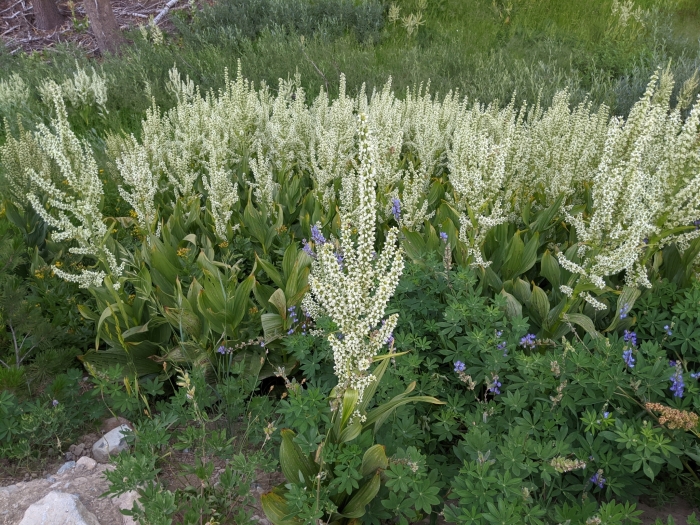California False Hellebore
(Veratrum californicum)
California False Hellebore (Veratrum californicum)
/
/

Kayla Sweeten
CC BY 4.0
Image By:
Kayla Sweeten
Recorded By:
Copyright:
CC BY 4.0
Copyright Notice:
Photo by: Kayla Sweeten | License Type: CC BY 4.0 | License URL: http://creativecommons.org/licenses/by/4.0/ | Rights Holder: Kayla Sweeten | Publisher: iNaturalist | Date Created: 2021-07-29T15:28:04-07:00 |











































































Estimated Native Range
Summary
Veratrum californicum, commonly known as California False Hellebore, is a deciduous perennial herb native to moist mountain meadows, streambanks, and wetland areas in the Western United States, particularly in the Sierra Nevada and Rocky Mountains. It typically grows 1 to 2 meters tall with an erect, unbranched, heavily leafy stem that resembles a cornstalk. The plant is characterized by its large, heavily veined, bright green leaves that can exceed a foot in length, and its numerous small, star-shaped flowers that range from greenish-white to yellowish-green. These flowers are clustered along the often-branched top of the stout stem, blooming from July to August, and are not particularly showy. The buds are tight green spheres before they open.
California False Hellebore is known for its striking foliage and architectural form, making it a bold statement in moist, shaded garden areas. It is often used in naturalistic plantings and riparian restoration projects. However, gardeners should be aware of its highly toxic nature, as all parts of the plant contain alkaloids that can be harmful if ingested. In cultivation, it requires consistently moist soil and can thrive in full sun to part shade, with a preference for cool, wet conditions. It is not drought-tolerant and requires soils with medium to slow drainage. Due to its toxicity, it is generally not troubled by pests or grazing animals, but it can be susceptible to root rot in poorly drained soils.CC BY-SA 4.0
California False Hellebore is known for its striking foliage and architectural form, making it a bold statement in moist, shaded garden areas. It is often used in naturalistic plantings and riparian restoration projects. However, gardeners should be aware of its highly toxic nature, as all parts of the plant contain alkaloids that can be harmful if ingested. In cultivation, it requires consistently moist soil and can thrive in full sun to part shade, with a preference for cool, wet conditions. It is not drought-tolerant and requires soils with medium to slow drainage. Due to its toxicity, it is generally not troubled by pests or grazing animals, but it can be susceptible to root rot in poorly drained soils.CC BY-SA 4.0
Plant Description
- Plant Type: Herb
- Height: 3-5 feet
- Width: 2-4 feet
- Growth Rate: Rapid
- Flower Color: Green, White
- Flowering Season: Spring
- Leaf Retention: Deciduous
Growth Requirements
- Sun: Full Sun, Part Shade
- Water: High
- Drainage: Medium, Slow
Common Uses
Bee Garden, Bird Garden, Butterfly Garden, Showy Flowers
Natural Habitat
Moist mountain meadows, streambanks, and wetland areas in the Western United States
Other Names
Common Names: California Corn Lily, California Veratrum, Skunk-Cabbage, Kalifornischer Germer, Jättenysrot
Scientific Names: , Veratrum californicum,
GBIF Accepted Name: Veratrum californicum Durand